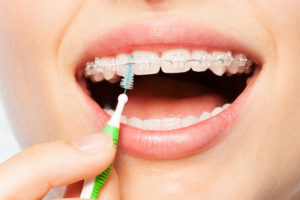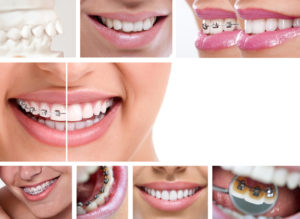Tips For A Tooth-Friendly Independence Day

The Fourth of July offers fun activities full of fireworks, parades and celebrations. From hamburgers to watermelon to all kinds of delicious treats, Independence Day is a fun day for everyone. Amid all the celebrating, though, it’s important that you take care of your teeth by watching what you eat and which activities you participate in, especially when wearing braces. There are lots of food options to choose from, but it’s important to keep your oral hygiene routine in check to prevent tooth decay. Find out how you can enjoy Independence Day and protect your teeth at the same time with these tips!
Commit To A Regular Routine
During this holiday season, our lives go from our normal day-to-day routines to boating, barbecuing and playing with sparklers as we watch the fireworks. The Fourth of July is a week full of festivities that involve a lot of food and fun, but it’s also a time that we easily forget to maintain a good oral hygiene routine. Our daily routine should include how we take care of our mouth and teeth, which means we can’t skimp on brushing and flossing, especially with braces. Plaque loves to sit on teeth as long as it can so that acid can form and eat at your tooth enamel. The longer plaque remains on your teeth, the more likely you are to experience tooth decay. During the week of the Fourth of July, it may be tempting to let your kids skip their normal bedtime routine due to a firework show or a late-night party, but even one night of not brushing and flossing lets harmful bacteria wreak havoc on your child’s teeth. Braces are especially susceptible to the effects of poor oral hygiene as they easily trap food particles around the brackets and underneath the archwire. One tip that can help your kids remember their oral health during the holiday is to keep a brushing calendar. These calendars are simple and easy to use, and they help kids stay on track each day, no matter what busy activity they’re participating in. You can find a brushing calendar at most department stores or you can ask your child’s dentist for one.
Avoid Sugary Foods and Drinks

beautiful blonde child drink water outdoor
One of the biggest mistakes that kids and adults alike make during the Fourth of July involves the type of food that they consume, specifically sugary foods or meals full of starches. It’s hard to resist a juicy burger with a slice of cherry pie, a sugary funnel cake or a cold lemonade, but these holiday foods are full of sugar and starches that not only affect your waistline, but your teeth, as well. Eating lots of foods high in sugar increases your risk of cavities, even if you’re good at brushing your teeth. It’s easy to hand your child a juice box or can of soda while they’re watching the parade, but it’s more beneficial if you offer healthier choices, like water, to keep them cool and hydrated. It’s even better if you can give your child water that contains fluoride, which hardens tooth enamel and safeguards teeth against cavities. For picky kids, milk and fresh juices are also alternatives to sugar-packed sodas and do a good job at protecting teeth. Before all of your fun activities begin, plan out snacks and healthy options for meals that you can provide that will protect kids’ teeth while they’re out having fun. For those with braces, make sure to avoid hard foods like corn on the cob, chips and candy, and don’t forget about sticky foods like caramel, taffy and licorice. Hard and sticky foods are notorious for breaking brackets and wires, which are no fun to deal with on the Fourth of July.
Protect Your Braces
Choosing healthy food options over the holidays is an essential part of protecting braces, brackets and wires. Braces are durable orthodontic appliances, but even they can break from a simple accident, like biting an apple. To maintain the structural integrity of your braces, make sure to brush after each meal (which may be difficult to do when you’re out and about) and use threadable floss to remove pesky food particles from getting stuck. You may even need to use a proxabrush, which is referred to as a “Christmas tree brush” that thoroughly cleans between each bracket whenever normal toothbrushing can’t do the trick. Keeping your teeth and braces clean will prevent tooth decay from developing and will help remind you to watch what you’re eating. Lastly, make sure to schedule regular checkups and cleanings with your orthodontist to remove any plaque that may have built up around your braces and ensure that their functioning correctly.
Schedule A Checkup
At Belmar Orthodontics, we are prepared to help you enjoy this year’s Independence Day by providing dental and orthodontic checkups. Our experienced staff is dedicated to your oral health throughout the entire year, and we can help you and your family receive the beautiful smiles that you deserve. To schedule a checkup or for more tips on how you can protect your family’s teeth this Independence Day, call our office at (303) 225-9016. Your journey to a healthy smile begins today!
Teeth Cleaning Habits To Have With Braces

Good oral hygiene is one of the most important goals that we should all have to maintain the health and strength of our teeth and gums. Once we get braces, however, our oral hygiene regimen will change to account for the new appliance in our mouths that we will have to clean around. Whether you have traditional braces or lingual braces, cleaning around the brackets and wires is essential in preventing cavities and tooth decay. There are many options to choose from to clean between teeth, such as a proxabrush, and other tools to thoroughly brush around the brackets, such as an electric toothbrush. Find out what all you can do to keep your smile healthy and bright with braces with these tips!
Extra Care For Teeth During Orthodontic Treatment
Orthodontic care is one of the most helpful and important dental treatments that patients have readily available to them. While there are many versions of braces that help straighten our teeth and fix misaligned bites, there are certain precautions that we need to take to ensure proper care for our orthodontic appliances and teeth. Brackets and wires in the mouth make it easier for food particles to get stuck in, which can lead to dental problems, like cavities. Proper oral hygiene is essential during your time with braces to avoid any preventable issues that can lengthen your treatment time or need special care to be fixed.
Since braces naturally create nooks and crannies where bacteria can hide, it is important to maintain a good oral hygiene regimen everyday so that you can avoid tooth decay and gum problems during orthodontic treatment. If teeth and brackets are not kept clean, permanent damage can occur to the tooth enamel, as well. When this occurs, white spots (tooth decay) can begin appearing on the teeth where the enamel surface has lost minerals, which cannot be reversed. Bleeding or inflamed gums, called gingivitis, is also common whenever patients don’t clean their teeth thoroughly enough with braces, and it can be very painful. While it is not likely that all of these issues will occur if you miss brushing your teeth or flossing well a few times, you will be more prone to an increased risk, which will hurt your oral health and complicate the rest of your orthodontic care.
Teeth Cleaning Options
Although cleaning your teeth with braces isn’t too difficult of a process for most patients, there are some tools that you can use to better clean around the hard-to-reach areas in your mouth and make your time cleaning more efficient. First and foremost, make sure that you (or your child) are brushing after each meal. It may seem insignificant, but brushing after you eat removes food particles that are stuck in braces, reduces staining and prevents bacteria buildup. Secondly, use a threadable floss or floss threader to clean underneath the wire of your braces. A floss threader works by inserting the pointed end between the teeth and under the archwire. From there, move it back and forth until it is able to thread the floss between the teeth. Then, you can floss the two teeth, on either side, to remove all food that may be stuck there. If you’re having trouble with your floss getting stuck, consider using waxed floss, which slides between the teeth easier and doesn’t get snagged.
After brushing and flossing, using a proxabrush is helpful in cleaning between each bracket. Commonly referred to as an interproximal brush or “Christmas tree brush,” a proxabrush is placed between two brackets, below the archwire, and uses an up-and-down motion to remove any lodged food particles that brushing and flossing can’t get to. Clean the brackets with the proxabrush on both sides, starting either up from the bottom or down from the top, and repeat between each tooth. Another option for hard-to-reach areas is an oral irrigator, which uses a pulsating stream of water to remove plaque and food debris. Mouthwash is also a helpful tool to kill and bacteria that may have been left after brushing and flossing. For an extra clean, try using an electric toothbrush to maximize cleaning and brush those difficult areas of the mouth that are hard to reach.
Braces-Friendly Diet
The foods we eat and the diet we have affect our oral health and can interfere with orthodontic appliances. Eating sugary or starchy foods can let plaque develop around the brackets, which can lead to cavities, staining or even gum disease. Sticky or chewy foods, such as caramel, taffy, chewing gum and corn on the cob, should also be avoided as they can easily become stuck between brackets and be difficult to remove. Hard foods, such as candy, beef jerky, nuts and popcorn, are also no-nos as they are known to break wires and loosen brackets. If you’re going to eat hard or crunchy foods, such as apples or carrots, make sure to cut them into small, bite-sized pieces to avoid any possible damage.
Regular Orthodontic Checkups
Even if you or your child are following these rules, it is essential that you visit with your orthodontist regularly so that they can monitor teeth movement and adjust any wires or brackets. Your orthodontist or hygienist can show you how to use the tools previously described and give you additional teeth cleaning supplies to aid you during treatment. For more questions about how to clean your teeth with braces or what foods to stay away from, contact Belmar Orthodontics at (303) 225-9016!
Adjusting to Lingual Braces

There are four main types of braces that include traditional metal braces, ceramic braces, lingual and Invisalign treatment. When patients want sturdy metal for effective straightening power, but they don’t want visible metal, lingual braces is the option to choose. This consists of an orthodontic appliance attached to the back of the teeth. With any orthodontic appliance attached to the teeth, there will be an adjustment period for patients.
Why Get Braces?
Many people wonder why they would need orthodontic treatment if they are already seeing a dentist. However, a dentist is not the same as an orthodontist. Both have gone to dental school, but only an orthodontist can correct bite and alignment issues that would cause oral health diseases, problems with speech and issues with eating. Straighter teeth are teeth that are easier to clean, helping you avoid oral health diseases.
The teeth are less likely to crack, chip, fracture or break from uneven biting pressure when they are straighter. Studies show that people who straighten their teeth often feel more attractive, confident and motivated, and others view them that way as well. Braces can not only help reduce your risk of oral health problems (or help them to go away), but they can make you feel like a million bucks from the beautiful smile you receive.

What Are Your Options?
In the past, traditional metal braces were the only braces option patients could get. Today, there are four main orthodontic options. Those include:
- Traditional Metal Braces – These are the classic metal bracket and wire option that is most commonly chosen by patients. Patients who chose this option come in to have their wires tightened at each appointment.
- Ceramic Braces – These braces are a close cousin to metal braces. They have the same bracket and wire design of metal braces, except that they are made out of ceramic material. This helps decrease demineralization during your orthodontic treatment. Ceramic material is also naturally white, helping these braces to blend in with your teeth more than metal would.
- Lingual Braces – These are metal braces that are placed on the back of your teeth. Instead of just a square bracket, the metal must be custom-made to the shape of the back of your teeth. This is a discrete option that adults and teens love.
- Invisalign Treatment – This is the most invisible option available to our patients. Invisalign is a series of transparent aligners that you wear at night and throughout the day. You can remove them for eating, playing sports, cleaning your teeth and more.
Adjusting to Lingual Braces and More
For many patients, the adjustment period with their orthodontic appliance will be a new experience. Getting braces on the teeth is a new and exciting chapter for anyone that is starting on their journey to a better smile. However, your mouth does have to physically adjust to orthodontic appliances. With traditional metal, ceramic, or lingual braces, there are orthodontic parts that will be bonded to the teeth with a cement-like bonding material.
The application of that bonding material with your teeth will place extra pressure on them for several days. You may have to take an over-the-counter painkiller (like Tylenol) to help ease that aching feeling. Soft foods like yogurt or pasta will be better after the braces application for sensitive teeth. Your tongue will have to adjust to orthodontic appliances as well. For traditional metal braces on the front of your teeth, they may feel bulky as they rest against your lips.
With lingual braces, your tongue may feel more crowded or may constantly run into the brackets. With both of these options, a patient’s mouth becomes used to the appliances so quickly that they won’t even notice the braces after a few days. Your smile won’t look bulky with your appliance, but it will start to look straighter over time. Cleaning your teeth will take a bit more work, but this too will become second nature to you. With each new braces adjustment, your teeth may feel a bit sore, but that feeling will go away quickly.

Keeping Your Smile Healthy
You can spend 18 or more months straightening your teeth, only to have them be decayed at the end of your treatment. However, this doesn’t have to happen if you are taking meticulous care of your teeth with braces on them. Patients should be brushing and flossing their teeth whether or not they have braces on them. The American Dental Association recommends that every person brush their teeth at least twice a day. With braces, you want to brush them very well after every meal to dislodge food that would cause decay.
Flossing is key as well, as flossing gets about 40% of your tooth surfaces that brushing misses. If you skip flossing all the time, all those tooth surfaces can decay. With braces, you won’t be able to do the normal flossing you’re used to. Lingual braces can be even harder if you can’t see where you are flossing. This is where flossing tools for braces come in handy. Invest in threadable floss or flossers (which is very similar). This is floss that you stick through the cracks in your teeth and pull through like a sewing needle. You floss the tooth, scraping the teeth as you go, and pull the floss all the way through the tooth to start on a new one. It only takes a minute or so more than normal flossing, but will help prevent decay with your lingual braces.
Braces Are an Investment
Your teeth may take a bit more time to keep clean with braces on them than they were before. However, with braces such as lingual braces, you’re making your smile straighter and more beautiful for years to come. That straightness will not only help make cleaning the teeth easier for years, but it will help your appearance and your confidence. If you want all the benefits of a beautiful, straight smile, call Belmar Orthodontics today at (303) 225-9016!

